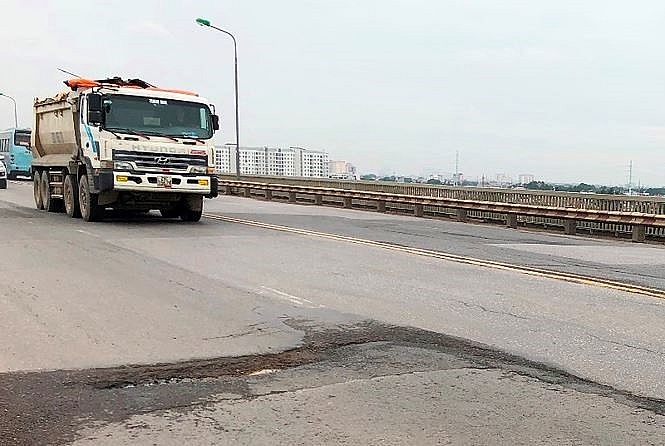Cracks reappear on Thang Long Bridge
 |
| Hanoi’s Transport Department has asked the Ministry of Transport to fix cracks and subsidence that have reappeared on the surface of Thang Long Bridge over the last few months, threatening road safety.-Photo tienphong.vn |
Thang Long Bridge, spanning about 3,116 metres, was built with Russian assistance in 1985, crossing the Red River to connect Noi Bai Airport with downtown Hanoi.
The bridge is under the management of the ministry’s Directorate for Roads of Vietnam. Since 2009, the ministry wanted to transfer the Bac Thang Long – Noi Bai Route (now known as Vo Van Kiet Street) including Thang Long Bridge to Hanoi for management because of the city’s expansion in 2008, the whole route is within Hanoi’s territory, making it an urban road.
However, the transfer was delayed as the bridge was being repaired at that time.
Authorities spent roughly VND100 billion ($4.8 million) on resurfacing the bridge in 2009, but severe cracks have since reappeared.
According to experts, one of the reasons for the poor quality of the road surface is that the rolling and pressing process of the stone mastic asphalt was below 120 degrees Celsius, negatively affecting the surface quality. Rainwater drainage systems have also not worked properly, leading to stagnant water and damaging the bridge’s surface.
Head of Road Management Department 1 under the directorate Tran Hung Ha told Tien Phong (Vanguard) newspaper that after the major maintenance in 2009, cracks would reappear on the bridge surface, especially after prolonged rain or heat with temperatures reaching over 40 degrees Celsius.
“Under harsh weather conditions, the bridge surface cracks and asphalt concrete breaks, weakening the structure with the weight of vehicles,” Hà said.
Last year, about VND1.4 billion was spent on fixing the bridge surface and in 2016, the maintenance cost over VND1 billion, he said.
Hanoi’s hesitation in taking ownership of the bridge is blamed on these high maintenance costs.
Hanoi asked the Transport Ministry and its relevant agencies to examine and fix the bridge’s surface before handing it over to the city.
What the stars mean:
★ Poor ★ ★ Promising ★★★ Good ★★★★ Very good ★★★★★ Exceptional
Related Contents
Latest News
More News
- Protect what’s next: towards a future free from meningococcal group B disease (December 05, 2025 | 18:00)
- New ILO report offers policy recommendations for disability inclusion (December 04, 2025 | 15:18)
- Maternal job loss may affect children’s mental health, research shows (December 03, 2025 | 19:11)
- Women lead Vietnam’s shift to climate-resilient agriculture (December 03, 2025 | 19:10)
- Experts highlight unpaid care work as key barrier to gender equality (December 03, 2025 | 15:15)
- Opportunities and inequalities for women workers in Vietnam's garment industry (December 03, 2025 | 09:00)
- Vietjet flights carry love to devastated central region (November 28, 2025 | 11:35)
- New initiative to boost the fight against domestic violence (November 26, 2025 | 10:00)
- South Korea funds IOM relief for Vietnam’s typhoon-affected communities (November 24, 2025 | 15:33)
- AI and human-centred values set to shape the future of HR in Vietnam (November 21, 2025 | 18:04)

 Tag:
Tag:





















 Mobile Version
Mobile Version